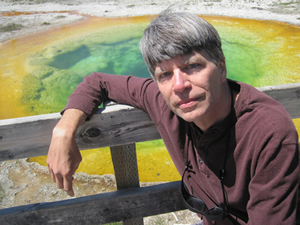The September “Second Sunday @ 5” concert (part of a Pan Harmonia series presented monthly in the intimate Altamont Theatre) left me in a quandary. I could write a full-length review about the ensemble while simply touching on the repertoire, or I could write a full-length review about the repertoire while simply touching on the performance. I made a third choice: an extended review that covers (1) the musicians, (2) Sunday’s program and (3) a plea for more works for this intriguing chamber ensemble.
Flute, Guitar and Bassoon
This is a combination of instruments that you don’t often hear, but you wonder why. Flute, guitar and bassoon blend tonally into an ensemble that is sonically so satisfying that more composers should consider it.
Kate Steinbeck performs on a wooden Chris Abell flute, and over the years I have come to respect Abell’s comment that “the pungent, reedy tone produced with a wooden flute is unequaled in any other material.” The brilliance of tone in precious metal alloy flutes is appropriate for symphony orchestras, but for chamber music, as the instrument maker says on his website “there is a quality of sound, a dark rich fullness in the wooden instruments, which the metal flutes can only approach.”
The classical guitar can be a treasure in the proper hands, played with skill and delicacy. Amy Bruscksch does so. I always enjoy hearing her in Pan Harmonia ensembles, where collaborators take cognizance of the fact that the guitar is a fundamentally quiet instrument.
It is barely a year since Rosalind Buda (pronounced “Bewda” as in “beauty”) settled in our area and hooked up with Pan Harmonia. Not since David Van Hoesen of Eastman Music fame retired have I heard a bassoonist with the sure richness of tone of Buda. (And as a plus, she also plays Highland bagpipes and Scottish smallpipes.)
Sunday’s Program
One set consisted of traditional Scottish melodies (a waltz, a strathspey and a set of reels) arranged for bassoon and guitar. This set included familiar tunes, but the remainder of the program consisted of Asheville premieres (and as Ms. Steinbeck noted, probably North Carolina premieres) of works by contemporary composers.
Tom G. Febonio is a Massachusetts-based crossover composer who has composed songs, guitar music and chamber works. His Blues for Matilda Op. 48, originally written for flute, cello and guitar, was inspired by his grandparents’ history. Born in 1882, they immigrated to the United States from Trasacco in the Abruzzi region of Italy. The town of Trasacco was completely destroyed in the earthquake of 1915. The three movements of the Febonio piece are entitled “Trasacc” (his grandmother always elided the final syllable of her home town), “Field Song” and “Abruzzi Wedding.” The compositional style reminded me of Nino Rota, who was most famous as Fellini’s film composer but who also was a noted musical educator. The “Field Song” managed somehow to denote honest labor and happy thoughts in a minor key.
Nathan Kolosko is a distinguished guitarist and teacher based in Portland, Maine. His four-movement Hungarian Trio again is originally for flute, cello and guitar. “Prelude” displayed some dense harmony and was to these ears difficult to process. “Round Dance” had hints of klezmer style, not surprising since klezmer itself has strong ties to Romanian dance music, and Hungary and Romania abut in the Carpathian Mountains. “Ancient Melody,” full of nostalgia and sadness, brought to mind some of the ethnomusicology of Bartók and Kodály, except that much Hungarian folk music is irregular in rhythm to match speech patterns, while Kolosko’s work has a strict rhythm. “Spinning Dance” had some “alla Turca” moments, and was a fitting conclusion.
The only works on the program that were actually composed for flute, guitar and bassoon were five pieces by Fredrik Holm, a Swedish composer now in England using music as therapy. At LinkedIn, Holm says “I work with sound and music to remove fear and stress and restore joy,” and he offers “Sound Awareness” workshops. This interest in the psychological effects of music is reflected in the titles of the works performed on this program: Freedom to Go and Awakening are the names of the suites, while “Learning,” “Moving On” and “A New Beginning” are the names of the individual works. Holm’s compositional influences include minimalism and New Age. He often uses repetitive rhythmic structures. I could not detect any real development; his music washed over me rather than telling me a story.
Music for Flute, Guitar and Bassoon
I repeat: wooden flute, guitar and bassoon blend tonally into an ensemble that is sonically so satisfying that composers should leap at the opportunity to compose for it. Just like a string quartet, it is a natural. Perhaps composers haven’t heard musicians of the quality of Mesdames Steinbeck, Bruscksch and Buda. Pan Harmonia should send recordings to all the contemporary composers that they admire in the hope that their beautiful sound will inspire composition. A historical precedent occurs to me: Johannes Brahms had stopped composing when he heard the clarinetist Richard Mühlfeld. Brahms then came out of retirement to compose a clarinet quintet, a clarinet trio and two clarinet sonatas out of his enthusiasm for Mühlfeld’s sound.











